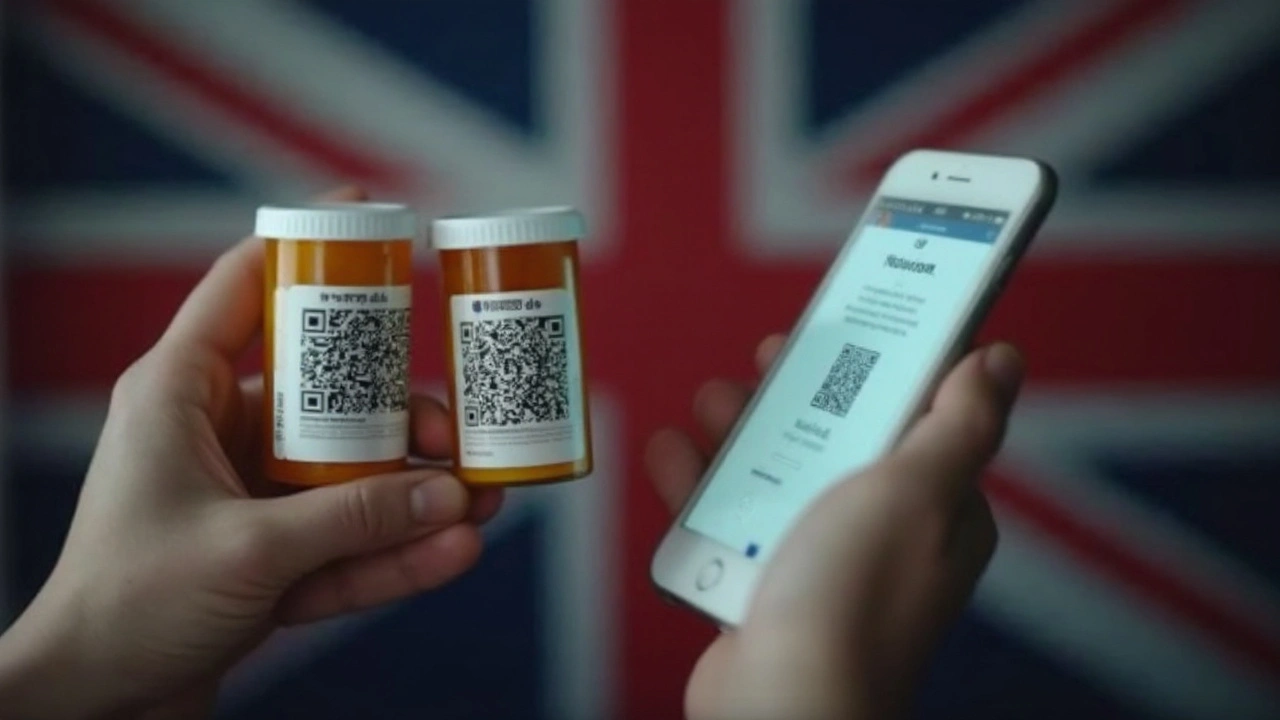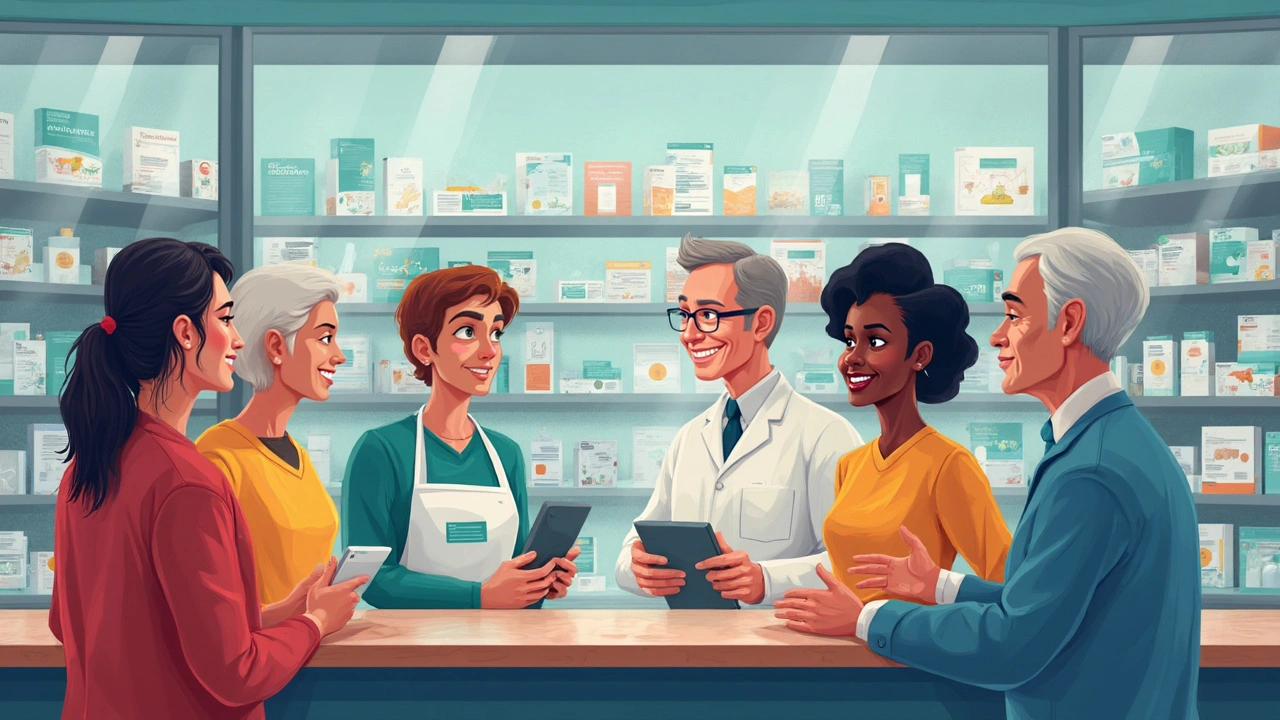How to Spot and Avoid Counterfeit Drugs When Shopping for Medicine Online
 Apr, 24 2025
Apr, 24 2025
The Dark World of Counterfeit Drugs: What You Need to Know
Counterfeit drugs aren’t just a problem for distant places or rare situations—they’re hanging out in the open, right in your browser, every time you think about buying medicine online. Most folks don’t realize how the fake medication market is booming. The World Health Organization revealed that in some regions, up to one out of ten medical products sold is either substandard or straight-up fake. That’s not a tiny problem.
What actually makes a drug counterfeit? It’s not just expired pills. Sometimes, the tablets look identical, but contain no active ingredient, too much, or even the wrong chemicals—ranging from chalk and powder to dangerous toxins. Criminal groups crank out fake pills using outdated machinery, black market ingredients, or even kitchen blenders. These fakes are so well made that even pharmacists struggle to spot the difference just by glancing at the packaging.
People often fall for these fake medicines because they’re cheaper, easier to access, or promise a prescription-free way to treat real health problems. The sad reality shows up in real statistics: the FDA has seized tons of contraband tablets at US borders in the past decade, amounting to millions of dollars. Even scarier, the death toll linked to bad batches can hit hundreds in a single year worldwide, especially when fakes replace life-saving meds like antibiotics or insulin.
The internet plays its role. There are thousands of online pharmacies, and around 95% don’t meet proper legal or safety standards according to the National Association of Boards of Pharmacy. It’s like the Wild West. Often, these rogue pharmacies set up sleek websites with amazing deals and promises of no doctor needed. Behind the screen? No real pharmacy license, no safety checks, and definitely no guarantee the meds are real.
If you’ve ever been tempted by an online drugstore offering rock-bottom prices on popular meds, you’re not alone. Many feel embarrassed talking to their doctors, run out of refills, or just want to save a little cash. That’s exactly why the counterfeit industry keeps thriving. There’s a big demand, a big supply… and way too little oversight.
Even big online platforms, not just sketchy websites, have struggled with this issue. In 2023, several large e-commerce companies came under fire for letting fake painkillers and erectile dysfunction drugs slip through their net. In most cases, buyers didn’t notice until side effects or lack of effectiveness clued them in. Don’t forget about social media, either. Fake pharma ads show up in DMs, comments, and stories, adding another layer of risk.
The threat isn’t just health damage—there’s also the risk of data theft, since many of these sites double as scams to harvest credit card info. So, while lower prices and convenience are tempting, the pay-off can be pretty serious if you don’t verify what you’re buying.

Get Smart: How to Recognize and Avoid Fake Medication Online
Alright, you’re about to order medication on the internet. What’s your first step? No shame—most people just Google the drug, click the first cheap-looking site, and start filling in their address. That’s risky business. Here’s how to keep yourself safe with a bit of detective work.
- Check the pharmacy’s credentials. Real online drugstores list their physical address, phone number, and license information clearly. If anything’s hidden or you can’t find proof of licensing with national pharmacy boards, skip it.
- Look for the VIPPS seal (Verified Internet Pharmacy Practice Sites) in the US or its equivalent in your country. If you click the seal, it should direct you to an official database—not just a logo pasted on the homepage.
- Beware of any website offering prescription drugs without actually requiring your prescription. That’s a textbook red flag.
Another trick: use the FDA’s BeSafeRx portal or similar international tools. Enter the website’s name, and you’ll usually get a report card. If your pharmacy came up with no results or a warning, that’s a sign to run away, not just walk.
Pill packaging matters. Real meds arrive in factory-sealed blister packs or sturdy bottles, never loose in baggies or plain white mailers. The colors should be bright, labels easy to read, batch numbers legible, and security stamps or holograms present and intact. If anything seems off, compare it to reference photos from the manufacturer’s own website. Even a tiny change in font, spelling errors, or fuzzy print can expose a fake.
Now, the actual pills: they should feel exactly like pharmacy-bought ones. Any weird smell, crumbling, discoloration, or chalky texture means stop and double-check. With chronic meds—like blood pressure pills, blood thinners, or birth control—it’s even more critical. A counterfeit pill may look and taste similar, but it won’t work, and that’s dangerous.
Let’s talk prices. If you find a deal that’s way below any competitor, it’s suspicious. Licensed pharmacies buy from certified wholesalers, and there’s a limit to how low the price can drop. For example, if one site sells brand-name EpiPens for $10 when everywhere else is $100 or more, something’s fishy. Don’t chase savings and risk your health.
Spotting fakes goes beyond packaging and prices. Some sites may use fake physician reviews, manipulated user ratings, or doctored images of their “facility.” Take a closer look at the About Us page, staff bios, and even the URL itself. If the address has odd extensions (.bz, .cc, .su) or odd hyphenation, it’s often a pop-up operation.
Here’s an eye-opener: studies have shown that up to 50% of meds sold online from illicit sites tested as counterfeit when analyzed by labs. The difference? They contained wrong ingredients or totally different drugs. That’s why it’s crucial to learn these checks.
Even if you’re savvy, fakes can sneak through. That’s where third-party lab testing comes in handy. Certain pharmacy watchdog groups let you verify package codes and report suspicious meds. You can also find mobile apps that check blister pack serials or authenticate security stickers using your phone camera.
Feeling a bit overwhelmed? There are guides and resources out there if you need help. This article on avoiding counterfeit drugs online lays out more steps to stay protected and shares tips on finding reliable sources. Bookmark it if you plan to order again.

Take Action: Steps to Safeguard Your Health
So you want to buy safe medication from the comfort of your home—no shame in wanting less hassle. But play it smart and put layers of protection between you and the fakes. Think of it like locking your doors at night: one deadbolt is good, but a few extra locks do better.
Start by using only well-known or government-approved online pharmacies. Stick to ones that require your prescription, not just a PayPal account. Always double-check the address—clever mimic sites can swap one letter and trick you. Look for secure checkout (https://, not just http://)—and double-check that padlock icon.
When you get your medicine, set aside two minutes for quality control. Check the packaging: real companies don’t do cheap tape-jobs or handwritten stickers. Scan the barcodes if you can. Real drugs almost always have batch numbers and expiration dates that you can verify with the manufacturer. Some companies even offer QR codes that link you directly to authentication pages.
If something seems wrong—misshapen tablets, weird colors, or broken seals—ask your local pharmacist for help. They see thousands of pill bottles and can often spot a fake right away. There are also hotlines and online reporting sites in many countries where you can upload photos and batch info for quick verification.
When feeling uncertain, don’t risk it. Trust your gut, and if in doubt, reach out to your healthcare provider. They can help you report the suspicious medicine and tell you if it’s safe to take or needs to go straight in the trash.
- Counterfeit drugs don’t just hurt you in the short run. There’s evidence they fuel antibiotic resistance, cause treatment failures, and even spark public health crises. It’s not only about your next refill—it’s also about the wider health community.
- Stay updated. International authorities (FDA, WHO, and the like) regularly publish lists of flagged online pharmacies. Check these before ordering from anyone new.
- Use discreet, privacy-protecting payment methods. This won’t keep your meds real, but it’ll help if the site is scamming for cash as well as drugs.
- If you’re traveling and need to order online, double-check local regulations. Different countries have different standards, and some places flood the market with fakes more than others.
Some experts believe that future tech—like blockchain tracking or tamper-proof packaging—will make fakes easier to catch. For now, awareness and a little skepticism are your best defense. Remember: counterfeiters get craftier every year, but with the right knowledge, they lose their edge.
So the next time you see that bargain bottle at half price, pause and think twice. Is saving a few bucks worth risking a fake—and maybe your health? With a bit of vigilance and some simple checks, you can steer clear of the counterfeits and stay healthy on your own terms.

Taylor Smith
May 1, 2025 AT 04:43Tammy Cooper
May 1, 2025 AT 14:36Alyssa Hammond
May 2, 2025 AT 22:34Jill Amanno
May 3, 2025 AT 13:02Kate Calara
May 5, 2025 AT 10:41Chris Jagusch
May 6, 2025 AT 22:17